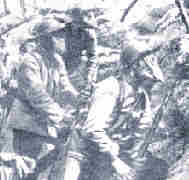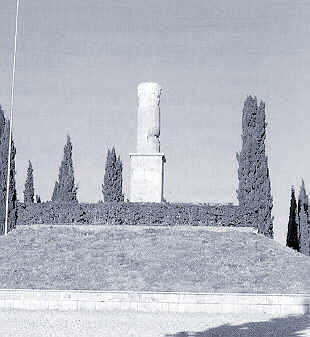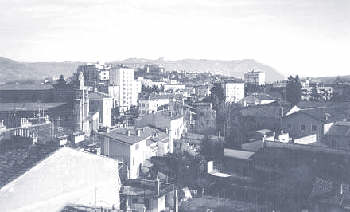

Gas Warfare Arrives on the
Italian Front - 1916
|
THE ISONZO
1916
|
Overview
If the campaign is protracted, the resources of the State will not be equal to the strain. . . then no man, however wise, will be able to avert the consequences that must ensue.
Sun Tsu - The Art of War
When Italy entered the Great War in 1915, it had hoped to tilt the balance of force against the Central Powers, ending the war quickly and allowing them to gain some long sought after territorial gains on the cheap. By the start of 1916, however, they found they were engaged in a protracted Total War placing undreamed of social and economic strains on the nation. Italy's government and military had to justify this burden with some successes on the battlefield. Their new allies had also started placing demands on them to continue on the offensive to alleviate pressures on their fronts. Austria-Hungary, likewise, had mobilized its entire dual-empire to support its war effort and needed to keep popular support. Also, to inhibit the disintegration threatened by the growth of ethnocentric nationalism, they could not afford to surrender any territory. On the Isonzo, all of this meant that in 1916 Italy needed to continue attacking and Austria-Hungary needed to continue defending. The war of attrition would continue growing with both sides blind to the inevitable consequences.

Fifth Battle of the Isonzo
March 9 - 17, 1916
In February of 1916, the German Army on the Western Front launched a tremendous assault on the city of Verdun and its surrounding fortress zone in northeast France. At a conference at Chantilly, France Marshal Joffre requested that Italy and Russia take the offensive on their respective fronts to reduce pressure on the French forces. Cadorna ordered a broad, but half-hearted, offensive nearly immediately.
Probes were made at Tolmino, Gorizia and the Carso. In most cases they were more demonstrations than full assaults. These died out after about a week because of bad weather and some bracing counterattacks staged by the Austrians, most notably at Santa Maria near Tolmino. The Italian Army also still needed more guns and artillery shells. The allies committed to sending Italy heavy artillery pieces; and further offensives were delayed until the new weapons and sufficient shells could be assembled.
Meanwhile, in the Trentino, the Austrians were marshalling their own forces for an assault. If they could mount a successful attack down off of the mountains, cross the Asiago Plateau, then occupy the Venetian Plain, they could cut-off all the Italian forces in the Carnic and Julian Alps and along the Isonzo. This major operation, called the Battle of Asiago by most and the Straffe [Punishment] Expedition by some began on May 15, 1916. Asiago will be the subject of another major article on La Grande Guerra and will not be discussed here in detail. It did, however, have some dramatic effects on the Isonzo Front and these need to be outlined briefly.

Memorial at Monte Sei Busi
At first the Austrian attack in the Trentino looked dramatically successful. Comando Supremo delayed further its plans for offensive operations and moved troops to reduce the threat to their rear. The deployment from the Isonzo to the Asiago Plateau was done fairly quickly since the Italian forces were travelling over shorter, interior lines. By early June the Austrian offensive was grinding to a halt. The Italian situation was further helped by the Russian response to their call for pressure on the Austrian Army on the Eastern Front. The subsequent series of actions known as the Brusilov Offensive were so successful that Austrian Supreme Commander Conrad von Hotzendorf was forced to give up his Trentino Offensive and move troops to distant Galicia. Italy's responded in turn by mounting a counter-offensive which ultimately regained part of the Asiago Plateau.
.
Back on the Isonzo Front, General Boroevic had decided to strengthen some local positions and the Italian Third was directed to mount attacks to discourage the Austrians shifting more men to the Trentino. Italian operations at Monfalcone were fairly low-scale, but the concurrent Austrian attack on the Carso marked a turning point for the Great War on the Italian Front. In their assaults on the Italian IX Corps at Mte San Michele and San Martino they introduced gases of the asphyxiant type leading to some quick local successes with heavy losses casualties amongst their opponents. The Italian killed, wounded and gassed totaled 4,600 men in just a few days.
As the Italian counteroffensive on the Trentino slowed, the focus of Comando Supremo shifted back to the Isonzo. Now, they decided, the time was at hand to capture strategic Gorizia. Again, they used their shorter interior lines to shift troops, this time back to the Isonzo sector. In August they would be ready to mount what would turn out to be the most successful of their eleven Isonzo Offensives.

Gorizia, Looking North to Monte Sabatino
Sixth Battle of the Isonzo
August 4 - 17, 1916
The Sixth Battle of the Isonzo is also know as the Battle of Gorizia after Italy's sole objective for the operation. For once, by practicing the Principle of Mass or Concentration and limiting the initial battlefield to an eight-mile wide front, General Cadorna was able to align 10 of his divisions against only 2 of his enemy's. This was made possible by the secrecy surrounding the preparations and his speed in switching back units from the Asiago sector.
The battle began with what was intended to be a diversionary artillery barrage and an infantry feint by units of two corps against Monfalcone to the south. The fighting got out of control, though, resulting in over five days of tough combat. The diversion failed to draw any Austrian units around Gorizia south.
The main advance began two days later from the towns of Oslavia and Padgora and featured the capture of Mte Sabatino and Mte Padgora despite strong resistance and heavy counterattacks. On August 8th, units of the 12th Italian Division were the first to enter Gorizia. The next day the Isonzo was crossed in force and the city secured. On the southern perimeter, the front broadened, growing to a width of fifteen miles. The fierce fighting characteristic of the Carso was once again renewed. Mte San Michele and Mte Sei Busi were finally seized, but at tremendous loss of life. The Italian advance on the Carso continued several miles to the dry river bed of the Vallone.
General Cadorna turned a bit cautious and Boroevic brought up reinforcements who dug-in at strong locations, and the operation ended fairly quickly. The advance of 3 miles depth over the 15-mile front with the capture of several strategic targets was the first major offensive success by the Italian Army during the Great War. Italian morale temporarily soared and on August 29th the government finally declared war on Germany. For their gains, the Italian Army had suffered 50,000 killed and wounded; on the defense, Austria-Hungary lost 42,000. Planning was initiated by Comando Supremo to expand the Gorizia bridgehead as soon as sufficient ordnance could be collected.

Exhausted Troops of the Firenze Brigade
Seventh Battle of the Isonzo
September 14 - 17, 1916
Eighth Battle of the Isonzo
October 10 - 12, 1916
Ninth Battle of the Isonzo
November 1 - 4, 1916
The next three battles on the Isonzo, all designed to expand the Gorizia bridgehead, were brief and bloody. Tactically, they featured sharp, uncoordinated local attacks on Austro-Hungarian positions which achieved some progress, but which, as usual, inflicted worse casualties the attackers [75,000] than the defenders [63,000]. These three grim battles probably started the downward spiral of morale in the Italian Army that would culminate a year later in the disaster of Caporetto.
The Second Army was given the objective of the Selva di Terranova, a wooded area lying back from the river in the gap between the Bainsizza Plateau in the north and the Carso to the south. During the Seventh Battle they captured Mte Rombon, but were forced to withdraw. Heavy losses by both armies then caused Cadorna to suspend offensive operations until October. Second Army's biggest success would take place in November when they captured Hill 171 near Mte St Marco behind Gorizia.
Third Army was ordered to advance once again through the Carso pushing the front six miles east. They faced tremendously determined opposition and after advancing nearly a mile in September, their high casualty rate necessitated a halt. The next month their advance was minimal. In early November they drove another mile close to the village of Castagnevizza where the front stabilized as winter approached. By the end of 1916 all the combatants along the Isonzo knew they were trapped in an inescapable war of attrition. Few, though, probably foresaw that even worse was coming in 1917.
|

|



